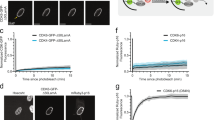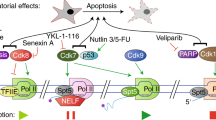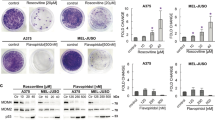Abstract
The cdk2 gene has been identified as a human cdc2/CDC28-related gene that encodes a protein kinase essential for the G1/S transition in mammalian cells, but not for the G2/M transition, which requires Cdk1, another p34cdc2/CDC28 homolog. Novel potential functions of Cdk2 have been uncovered by using two potent and specific inhibitors of its kinase activity, roscovitine and olomoucine, on human wt p53-expresser untransformed and tumor-derived cells. At concentrations equal or superior to respectively 30- and 20-fold their in vitro IC50 values for cyclin B/Cdk1, cyclin A/Cdk2 and cyclin E/Cdk2, the Cdk inhibitors precipitately induce a dramatic nuclear accumulation of wt p53 and a delocalization of nucleolin from the nucleolus in all interphase cells, whatever their cell cycle status, acting in this way like the DNA-damaging drug, mitomycin C (7 μg/ml). These early events are soon followed by a nucleolar fragmentation in both normal and tumor cells in the presence of the Cdk inhibitors but not in the presence of the DNA-damaging drug. Yet, treatment with either type of compounds eventually triggers rapidly the death of the tumor cells and, much more slowly, that of the normal cells. The Cdk inhibitors, however, stimulate cell death from any stage of the cell cycle, whereas the DNA-damaging drug kills more efficaciously S phase cells. These observations provide a hint that the Cdk2 kinase might be involved in controlling the nuclear levels of the tumor suppressor wt p53 protein and in maintaining the nucleolar integrity and function, linking in this way the cell division cycle machinery to survival functions and overall cell metabolism via the control of nucleocytoplasmic transport and of ribosome production.
This is a preview of subscription content, access via your institution
Access options
Subscribe to this journal
Receive 50 print issues and online access
$259.00 per year
only $5.18 per issue
Buy this article
- Purchase on Springer Link
- Instant access to full article PDF
Prices may be subject to local taxes which are calculated during checkout








Similar content being viewed by others
References
Alcorta DA, Xiong Y, Phelps D, Hannon G, Beach D and Barrett JC. . 1996 Proc. Natl. Acad. Sci. USA 93: 13742–13747.
An B, Diniley KE, Zhang LL, Termin TA, Meijer L and Ping Dou Q. . 1997 Oncology Reports 4: 1129–1134.
Atadja P, Wong H, Garkavtsev I, Veillette C and Riabowol K. . 1995 Proc. Natl. Acad. Sci. USA 92: 8348–9352.
Bates S, Bonetta L, MacAllan D, Parry D, Holder A, Dickson C and Peters G. . 1994 Oncogene 9: 71–79.
Connell-Crowley L, Solomon MJ, Wei N and Harper JW. . 1993 Mol. Biol. Cell 4: 79–92.
David-Pfeuty T and Nouvian-Dooghe Y. . 1996 Oncogene 13: 1447–1460.
David-Pfeuty T, Chakrani F, Ory K and Nouvian-Dooghe Y. . 1996 Cell Growth Diff. 7: 1211–1225.
David-Pfeuty T and Nouvian-Dooghe Y. . 1997 Cancer Res. 57: 4482–4487.
De Azevedo WF, Leclerc S, Meijer L, Havlicek L, Strand M and Kim S-H. . 1997 Eur. J. Biochem. 243: 518–526.
Dulic V, Lees E and Reed SI. . 1992 Science 257: 1958–1961.
El-Deiry WS, Tokino T, Velculescu VE, Levy DB, Parsons R, Trent JM, Lin D, Mercer WE, Kinzler KW and Vogelstein B. . 1993 Cell 75: 817–825.
Elledge SJ and Spottswood MR. . 1991 EMBO J. 10: 2653–2659.
Elledge SJ, Richman R, Hall FL, Williams RT, Lodgson N and Harper JW. . 1992 Proc. Natl. Acad. Sci. USA 89: 2907–2911.
Fang F and Newport JW. . 1991 Cell 66: 731–742.
Fischer U, Huber J, Boelens WC, Mattaj IW. . 1995 Cell 82: 475–483.
Forsburg SL and Nurse P. . 1991 Ann. Rev. Cell. Biol. 7: 227–256.
Gautier T, Robert-Nicoud M, Guilly M-N and Hernandez-Verdun D. . 1992 J. Cell Sci. 102: 729–737.
Ghisolti-Nieto L, Joseph G, Puvion-Dutilleul F, Amalric F and Bouvet P. . 1996 J. Mol. Biol. 260: 34–53.
Ginisty H, Amalric F and Bouvet P. . 1998 EMBO J. 17: 1476–1486.
Girard F, Strausfeld U, Fernandez A and Lamb N. . 1991 Cell 67: 1169–1179.
Gray NS, Wodicka L, Thunnissen A-MWH, Norman TC, Kwon S, Espinoza FH, Morgan DO, Barnes G, LeClerc S, Meijer L, Kim S-H, Lockhart DJ and Schultz PG. . 1998 Science 281: 533–538.
Gu Y, Rosenblatt J and Morgan DO. . 1992 EMBO J. 11: 3995–4005.
Hara E, Smith R, Parry D, Tahara H, Stone S and Peters G. . 1996 Mol. Cell Biol. 16: 859–867.
Harper JW, Adami Gr, Wei M, Keyomarsi K and Elledge SJ. . 1993 Cell 75: 805–816.
Harper JW, Elledge SJ, Keyomarsi K, Dynlacht B, Tsai L-H, Zhang P, Dobrowolski S, Bai C, Connell-Crowley L, Swindell E, Fox MP and Wei N. . 1995 Mol. Biol. Cell. 6: 387–400.
Jiang W, Kahn SM, Zhou P, Zhang Y-J, Cacace AM, Infante AS, Doi S, Santella RM and Weinstein IB. . 1993 Oncogene 8: 3447–3457.
Karn J, Watson JV, Lowe AD, Green SM and Vedeckis W. . 1989 Oncogene 4: 773–787.
Koff A, Giordano A, Desai D, Yamashita K, Harper JW, Elledge S, Nishimoto T, Morgan DO, Franka RB and Roberts JM. . 1992 Science 257: 1689–1694.
Lees E. . 1995 Curr. Biol. 7: 773–780.
Matsushime H, Ewem M, Strom D, Kato J-Y, Hanks S, Roussel M and Sherr C. . 1992 Cell 71: 323–334.
Meijer L, Guidet S and Tung HYL. (eds) . 1995 Progress in Cell Cycle Research vol. 1 Plenum Press 373 pp. (29 chapters).
Meijer L. . 1996 Trends Cell. Biol. 6: 393–397.
Meijer L, Guidet S and Vogel L. (eds) . 1996 Progress in Cell Cycle Research vol. 2 Plenum Press 284 pp. (24 chapters).
Meijer L, Guidet S and Vogel L. (eds) . 1997a Progress in Cell Cycle Research vol. 3 Plenum Press 321 pp. (24 chapters).
Meijer L, Borgne A, Mulner O, Chong JPJ, Blow JJ, Inagaki N, Inagaki M, Delcros J-G and Moulinoux J-P. . 1997b Eur. J. Biochem. 243: 527–536.
Meijer L and Kim S-H. . 1997 Methods Enzymol. 283: 113–128.
Mélèse T and Xue Z. . 1995 Curr. Opin. Cell Biol. 7: 319–324.
Meyerson M, Enders GH, Wu C-L, Su L-K, Gorka C, Nelson C, Harlow E and Tsai L-H. . 1992 EMBO J. 11: 2909–2917.
Meyerson M and Harlow E. . 1994 Mol. Cell. Biol. 14: 2077–2086.
Michieli P, Chedid M, Lin D, Pierce JH, Mercer WE and Givol D. . 1994 Cancer Res. 54: 3391–3395.
Musgrove EA, Lee CSL, Buckley MF and Sutherland RL. . 1994 Proc. Natl. Acad. Sci. USA 91: 8022–8026.
Nigg EA. . 1992 Adv. Cell. Mol. Biol. 4: 103–131.
Ninomoya-Tsuji J, Nomoto S, Yasuda H, Reed SI and Matsumoto K. . 1991 Proc. Natl. Acad. Sci. USA 88: 9006–9010.
Noda A, Ning Y, Venable SF, Pereira-Smith OM and Smith JR. . 1994 Exp. Cell Res. 211: 90–98.
Ohtsubo M and Roberts J. . 1993 Science 259: 1908–1912.
Ohtsubo M, Theodoras AM, Schumacher J, Roberts JM and Pagano M. . 1995 Mol. Cell. Biol. 15: 2612–2624.
Ongkeko W, Ferguson DJP, Harris AL and Norbury C. . 1995 J. Cell Sci. 108: 2897–2904.
Pagano M, Pepperkok R, Verde F, Ansorge W and Draetta G. . 1992 EMBO J. 11: 761–771.
Pagano M, Pepperkok R, Lukas J, Baldin V, Ansorge W, Bartek J and Draetta G. . 1993 J. Cell Biol. 121: 101–111.
Pardee B. . 1974 Proc. Natl. Acad. Sci. USA 71: 1286–1290.
Pardee B. . 1989 Science 246: 603–608.
Paris J, Guellec RL, Couturier A, Guellec KL, Camonis J, MacNeill S and Philippe M. . 1991 Proc. Natl. Acad. Sci. USA 88: 1039–1043.
Park DS, Farinelli SE and Green LA. . 1996 J. Biol. Chem. 271: 8161–8169.
Quelle DE, Ashmum RA, Shurtleff SA, Kato J, Bar-Sagi D, Roussel MF and Sherr CJ. . 1993 Genes Dev. 7: 1559–1571.
Resnitzky D, Gossen M, Bujard H and Reed SI. . 1994 Mol. Cell. Biol. 14: 1669–1679.
Resnitzky D and Reed SI. . 1995 Mol. Cell. Biol. 15: 3463–3469.
Reznikoff CA, Yeager TR, Belair CD, Savelieva E, Puthenveettil JA and Stadler WM. . 1996 Cancer Res. 56: 2886–2890.
Rosenblatt J, Gu Y and Morgan DO. . 1992 Proc. Natl. Acad. Sci. USA 89: 2824–2828.
Roth J, Dobbelstein M, Freedman DA, Shenk T and Levine AJ. . 1998 EMBO J. 17: 554–564.
Sakaguchi K, Sakamoto H, Lewis MS, Anderson CW, Erickson JW, Appella E and Xie D. . 1997 Biochem. 36: 10117–10124.
Schutte B, Nieland L, Engeland M, Henfling MER, Meijer L and Ramaekers FCS. . 1997 Exp. Cell Res. 236: 4–15.
Sedlacek HH, Czech J, Naik R, Kaur G, Worland P, Losiewicz M, Parker B, Carlson B, Smith A, Senderowicz A and Sausville EA. . 1996 Ann. Oncol. 7: (Suppl. 1) 77.
Serrano M, Hannon GJ and Beach D. . 1993 Nature 366: 704–707.
Shaw PJ and Jordan EG. . 1995 Annu. Rev. Cell Dev. Biol. 11: 93–121.
Sinclair DA, Mills K and Guarente L. . 1997 Science 277: 1313–1316.
Stommel JM, Marchenko ND, Jimenez GS, Moll UM, Hope TJ and Wahl GM. . 1999 EMBO J. 18: 1660–1672.
Tsai L-H, Harlow E and Meyerson M. . 1991 Nature 353: 174–177.
Tsai L-H, Lees E, Faha B, Harlow E and Riabowol K. . 1993 Oncogene 8: 1593–1602.
van den Heuvel S and Harlow E. . 1993 Science 262: 2050–2054.
Vesely J, Havlicek L, Strnad M, Blow JJ, Donella-Deana A, Pinna L, Letham DS, Kato JY, Dévitaud L, Leclerc S and Meijer L. . 1994 Eur. J. Biochem. 224: 771–786.
Wilson GD, McNally NJ, Dunphy E, Kärcher H and Pfragner R. . 1985 Cytometry 6: 641–647.
Wimmel A, Lucibello F, Sewing A, Adolph S and Müller R. . 1994 Oncogene 9: 995–997.
Worland PJ, Kaur G, Stetler-Stevenson M, Sebers S, Sartor O and Sausville EA. . 1993 Biochem. Pharmacol. 46: 1831–1840.
Xiong Y, Zhang H and Beach D. . 1992 Cell 71: 505–514.
Xiong Y, Zhang H and Beach D. . 1993a Genes & Dev. 7: 1572–1583.
Xiong Y, Hannon GJ, Zhang H, Casso D, Kobayashi R and Beach D. . 1993b Nature 366: 701–704.
Xu Z and Mélèse T. . 1994 Trends Cell Biol. 4: 414–417.
Zhang H, Hannon GJ and Beach D. . 1994 Genes & Dev. 8: 1750–1758.
Zindy F, Lamas E, Chenivesse X, Sobczak J, Wang J, Fesquet D, Henglein B and Brechot C. . 1992 Biochem. Biophys. Res. Commun. 182: 1144–1154.
Acknowledgements
I am particularly indebted and grateful to Laurent Meijer who enabled this work by providing us generously with roscovitine, purvalanol B, olomoucine and iso-olomoucine and for his critical reading of the manuscript. I am thankful to Drs Evelyne May and Vincent Favaudon for providing the MCF-7 cell line and the IMR-90 fibroblasts, respectively, as well as to Drs Gérard Joseph and Tony Hunter for supplying the anti-nucleolin and anti-cyclin A antisera, respectively. My acknowledgments extend to Madame Yolande Nouvian-Dooghe for her valuable technical assistance, to Madame Dany Rouillard for her help with the flow cytometry experiments and to Madame Irène Gaspard for her expert artwork. The study was supported by the Centre National pour la Recherche Scientifique, the Curie Institute and the Association pour la Recherche sur le Cancer.
Author information
Authors and Affiliations
Rights and permissions
About this article
Cite this article
David-Pfeuty, T. Potent inhibitors of cyclin-dependent kinase 2 induce nuclear accumulation of wild-type p53 and nucleolar fragmentation in human untransformed and tumor-derived cells. Oncogene 18, 7409–7422 (1999). https://doi.org/10.1038/sj.onc.1203103
Received:
Revised:
Accepted:
Published:
Issue Date:
DOI: https://doi.org/10.1038/sj.onc.1203103
Keywords
This article is cited by
-
CDK9 activity is critical for maintaining MDM4 overexpression in tumor cells
Cell Death & Disease (2020)
-
Induction of Apoptosis in G1/S Blocked HeLa Cells by R-Roscovitine: A Preliminary Study
Proceedings of the Zoological Society (2014)
-
Polyamine depletion enhances the roscovitine-induced apoptosis through the activation of mitochondria in HCT116 colon carcinoma cells
Amino Acids (2012)
-
Cyclin-Dependent Kinase Modulators and Cancer Therapy
BioDrugs (2012)
-
ISG20L1 is a p53 family target gene that modulates genotoxic stress-induced autophagy
Molecular Cancer (2010)



